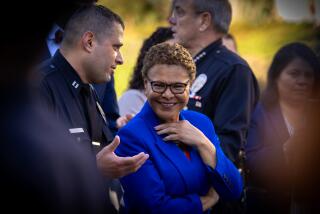Mayor Bass calls for overhaul of LAPD discipline system, more detectives to work cases

- Share via
Los Angeles Mayor Karen Bass has laid out her priorities for the LAPD, calling on Police Chief Michel Moore to add detectives to boost crime clearance rates; shorten the time it takes to recruit, hire and train new officers; and overhaul a discipline system she said too often lets problem cops off the hook for misconduct.
In the clearest indication yet of the direction she will take on public safety, Bass told The Times last week that she wants to see broad change in the Police Department, but her focus at the moment is on goals that are realistic given where the department and city are today.
“One of the things that I believe needs to be changed is the culture, and I don’t think you can legislate that. I think that’s a leadership issue,” she said Thursday. “I have done legislation in many different areas that I would love to do more and see it go further. At the end of the day, I like to promote policies that will actually be implemented.”
Last month, Bass disappointed some of the city’s most vocal activist groups by supporting Moore’s request for a second term. Moore has said he intends to serve for two or three years before stepping aside for a new chief. At the same time, the mayor has promised to tackle the issue of public safety by pursuing strategies that don’t involve the LAPD.
Bass said all of the goals were important and interconnected; but if she were to rank them by urgency, she would prioritize “crime reduction, personnel reform, alternative response and community policing.”
A summary of her public safety goals obtained by The Times makes clear that reducing the number of police shootings remains a top priority. Her plan shows that she expects the department to report back to her and the City Council by March on its updated training measures as it tries to curb officers’ use of deadly force.
Later this year, she expects the department to report back on an “evidence-based training model on de-escalation tactics that can be measured and verified in the officer evaluation process,” according to the summary, as well as to apply “lessons learned from [police shootings] committed in 2022.”
After the release of body-camera footage from three fatal police encounters at the beginning of the year, Bass said she had “grave concerns about the deeply disturbing tapes.”
She said her administration would also work with the county to “expand the capabilities” of the Mental Evaluation Unit, which pairs officers with county social workers trained in de-escalating standoffs with people thought to be mentally ill. For now, the units aren’t available 24/7, in part due to a shortage in mental health practitioners, police officials said.
Acknowledging that the causes of gun violence are varied and complex, Bass said she sees a need to hire more detectives and take advantage of the state’s red flag laws to remove guns from people who are unfit to possess them. She also wants to launch a citywide education campaign on what constitutes a hate crime and how people can report them to authorities.
Bass said she wants to ensure the violence reduction efforts are concentrated in the communities most affected by serious crimes, while acknowledging that crime in L.A. has declined dramatically in recent decades. Los Angeles ended 2022 with fewer homicides and shootings than in 2021, and so far this year most crime categories are down year over year, police say. A key concern, Bass said, is improving homicide clearance rates, which fell from roughly 77% in 2019 to 66% in 2021. Among Black and Latino victims, homicides were solved at an even lower rate, she said.
As a result, she said, she wants to find funding to hire more homicide detectives to work those cases. At the same time, she said that combating crime also requires investing in gang prevention and intervention programs.
“Well, let me just say that the homicide rate, as you said, has plateaued, but it’s disproportionate in certain communities, and the clearance rate is very low,” she said. “So my policy platform that I developed during the campaign calls for extra attention, extra officers, extra detectives, to raise the clearance rate of homicides.”
Such reforms go hand-in-hand with rebuilding community trust, she said. Using a mix of public and private funding, she said, she plans to expand the department’s heralded Community Safety Partnership program, which since its launch in 2011 has been credited with reducing violent crime and improving relationships in some of the city’s most troubled housing developments. She ordered the LAPD to report on the program’s metrics by next month, one of several deadlines imposed by Bass’ plan.
Bass acknowledged that many of her reforms and metrics depend on addressing a staffing shortage at the LAPD, whose hiring has struggled to keep pace with retirements and other departures. She said she intends to work with the city personnel department, which runs the background process, to not only bring in more diverse candidates but also clear an administrative bottleneck so severe that a recent Police Academy class had 22 recruits — down from a previous average of 50 to 60.
Her plan calls for developing a strategic plan with the personnel department to increase the number of new recruits and lateral hires by 500 a year, “including innovative recruitment strategies targeting non-traditional talent such as social workers, teachers and nurses.”
Bass said there was no clear timeline for another of her campaign promises: to add hundreds of civilian employees at the LAPD as a way of freeing officers from performing clerical duties and getting back onto the streets.
The force has about 9,200 officers, but about 600 are expected to retire or leave for other reasons in the next year — about 20% higher than the typical departure rate, Moore said. On the campaign trail, Bass pledged to increase the department to 9,700 officers.
Bass said that she also wants to strengthen systems for identifying and rooting out officers with ties to right-wing domestic terrorist groups but that the details of that plan have been left up to Moore. The plan also calls for her newly appointed director of public safety to hire “an outside evaluator” to examine the department’s complaint system.
The mayor said she wants to work with other city leaders on ways to overturn Charter Amendment C. In recent months, Bass, Moore and the head of the Police Commission have gone on the record calling for a repeal of the measure, passed in 2017, which gives officers facing serious discipline the choice of appearing before an all-civilian panel or the traditional one made up of two officers and one civilian.
Last year, officers almost exclusively opted for civilian-only panels, which a report by the LAPD’s inspector general found frequently overturned Moore’s recommendations for termination.
“A lot of people say it’s not working, and so I think that needs to be examined up to and including removing it and changing it, but it needs to be examined. I’m not sure if anybody’s a proponent of it,” said Bass, pointing out that 69 officers Moore sought to fire remain on the force today.
On Friday, Councilmembers Hugo Soto-Martinez and Tim McOsker introduced a motion to eliminate the all-civilian option, among other changes aimed at improving accountability.
Bass rode to office, in part, on the promise of balancing reform and public safety. But while taking a more moderate road may have helped get her elected, for some department critics, Bass’ plan doesn’t go nearly far enough to address what they see as the department’s deeply ingrained issues.
“If Karen Bass is meant to represent a change, this public safety plan doesn’t reflect that plan. It’s straight up business as usual,” said Matyos Kidane, an organizer with the technology watchdog group Stop LAPD Spying Coalition.
Of particular concern, he said, is that the plan still falls back on the logic that more police officers equals more safety — something that his group rejects. “There’s a lot here about maintaining LAPD numbers, and to us it’s an obfuscation; it’s misleading to say that there aren’t enough officers available to respond to 911 calls.”
Others saw it differently.
Longtime LAPD observer Connie Rice said Bass does a good job of balancing police reform and public safety, with an understanding that a one-size-fits-all approach won’t work for a city like Los Angeles, which at 500 square miles is simply too vast and diverse. As such, a more targeted approach such as the Community Safety Partnership is needed, she said.
A more crucial element of the mayor’s plan was the need to weed out officers who harbor extremist views, which Rice called an urgent problem across law enforcement that is the focus of a recent state law.
“The real problem is trying to keep the good people that are left from leaving, because they need new leadership,” Rice said.
In the view of Ed Obayashi, a police training expert, law enforcement lawyer and Northern California deputy, the mayor’s plan “is something every large department works on” and not exactly “groundbreaking.”
“The big question: Is the city considering adjusting the hiring standards here?” Obayashi said. “That has been a rocky road for departments.”
The normally outspoken Los Angeles Police Protective League has remained largely silent since Bass’ election and Moore’s reappointment. But in a statement, the league’s board said “improving public safety in Los Angeles must move beyond the esoteric debates that lead to gridlock and move toward identifying the granular details needed for action.”
A spokesman for the league, the union that represents the city’s rank-and-file police officers, said the requests coming from the mayor’s office seem reasonable.
The league’s only concern, he added, was that in the department’s rush to recruit, hire and train more officers to fill its sagging ranks, it was also lowering its job standards. Specifically, he said, the league had heard anecdotally that certain officers were being pushed through the hiring process even if they didn’t meet physical fitness standards.
“You start doing that, it creates Memphis problems. It creates Rampart,” he said, referring to the LAPD’s Rampart corruption scandal of the 2000s and to the Southern city’s embattled police force, which was thrust into the international spotlight after the beating that caused the death of Tyre Nichols last month.
Horace Frank, a retired assistant LAPD chief, said, “It is great that these items are being asked about by the new mayor. It is certainly indicative that the new mayor has very keen interest and wants to know what’s is going on within the LAPD as she should.”
But Frank also cautioned that, “when it comes to hiring, the LAPD has no control.” He said the department can “go out, encourage, hold seminars and prepare people.”
After that, though, “it is all about the city’s personnel department,” he said. “I think it would be accomplishment to have the department and the chief of police have a much bigger role in the hiring process similar to that of the Fire Department.”
Times staff writers Kevin Rector and David Zahniser contributed to this report.
More to Read
Sign up for Essential California
The most important California stories and recommendations in your inbox every morning.
You may occasionally receive promotional content from the Los Angeles Times.












